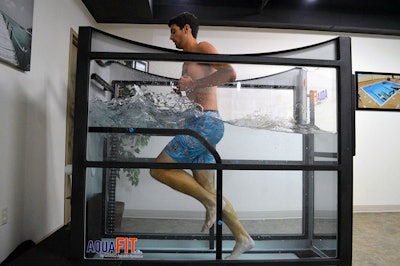
Injuries are inevitable. How athletic programs plan for the health and safety of their athletes’ injury recovery can determine the success of a sport’s season.
Patellofemoral Pain Syndrome (PFP) is one of the most common types of knee pain experienced in the United States, specifically among athletes. Contributing factors to the development of PFP include, but are not limited to, thigh muscle weakness, repetitive movements, and certain hip and knee coordination patterns involved in running and jumping activities. With this list of known causes, it’s obvious that athletes are the most “at risk” population for developing PFP. Since PFP does not heal on its own, treatment from a physical therapist or athletic trainer is the recommended treatment option. Studies show that the most effective treatment plans include a combination of land and aquatic therapy to increase strength and stability of the knee and surrounding musculature.
Water vs. land
Keeping athletes healthy and in the game all season is a huge challenge for coaches and trainers. Programs that offer athletes aquatic therapy and conditioning can rehab injured athletes more quickly and keep healthy athletes strong to avoid future injury.
Utilizing the natural properties of water, like buoyancy, allows athletes to work out harder, at higher intensity levels, more days in a row, as compared to land-based workouts. Because of decreased weight-bearing in water, general wear and tear on joints, risk for injury, and muscle soreness are reduced. With 360 degrees of resistance, working out in water forces athletes to work their muscles both concentrically and eccentrically. With concentric and eccentric muscle contractions occurring with all movements, the athlete is making progress with power and speed while building muscle mass and increasing strength. By keeping athletes properly conditioned, with focus on increasing strength and flexibility, risk of injury decreases.
Aquatic therapy using a pool and underwater treadmill system, such as the AquaFit underwater treadmill, provides benefits to injured athletes throughout all phases of recovery. By utilizing the properties of water in the functional recovery process, activities and exercises can be introduced earlier than on land, which can reduce recovery time and produce better results.
Why water?
Anterior knee pain commonly associated with PFP generally worsens with running, squatting or walking up and down the stairs; the result of mechanical overload on the knee joint.
By exercising in the water:
- Buoyancy unweights the body, resulting in less stress placed on the knee joint. This allows athletes to exercise without increased pain and irritation to the joint, making it possible to continue with strength and mobility training without increasing pain.
- Viscosity provides 360 degrees of resistance throughout the workout, engaging the knee joint and surrounding musculature in strength and stabilization exercise. By focusing on the surrounding structures, and not just the knee joint itself, patellar malalignment can be corrected.
- Hydrostatic pressure will help to minimize any swelling and increases oxygenated blood flow to muscles and tissues to promote healing.
Exercising in the water has been proven to reduce anxiety resulting from fear of increased pain, helping athletes to perform workouts utilizing the proper techniques without harmful compensations. Water provides a safe environment reducing the risk for fall or injury, so exercises and activities can progress more quickly, with a greater focus on balance and stability, resulting in a quicker return to sport and reduced risk for re-injury.
Safe and quicker re-entry
Creating and maintaining an athletic program with top performing athletes requires planning and training when dealing with injuries and treatment. Repetitive motion injuries and lengthy recovery protocols make safely and quickly returning athletes to the game difficult.
By utilizing aquatic therapy and the properties of water, functional sport-type tasks can be initiated sooner with less pain and risk for re-injury. This allows for simultaneous strength, stability, and motor control training through all phases of rehab. With athletes reporting decreased pain and joint swelling after aquatic treatment/workout sessions, the AquaFit can be used for supplementary exercise on rest-and-recovery days to continue progress toward treatment goals for a safer and faster return to sport.
By utilizing aquatic therapy and underwater treadmills, recovery time for repetitive motion injuries can be decreased. With water providing buoyancy and resistance with each workout, and a safe treatment environment, athletes can rehab and condition without pain and without fear of increased pain.
Learn more about adding aquatic therapy to your athletic program with equipment customizable to each athlete and injury. Visit Hudsonaquatic.com/athletic-business for more information.
This sponsored content was provided by Hudson Aquatic Systems. What is sponsored content?












